ASUS P5E3 Deluxe: X38 and DDR3 arrives... almost
by Gary Key on September 18, 2007 4:00 AM EST- Posted in
- Motherboards
ASUS P5E3 Deluxe: Board Layout and Features
ASUS has designed a board that reminds us of cars from yesteryear: large, solid, and seemingly engineered as if it's a tank ready for the front lines. The board easily installs into a variety of cases from Antec and Cooler Master. The majority of connections are easily reached within a full size ATX case. The board features an eight-phase voltage regulator system that contributes to the excellent stability we experienced throughout testing. The P5E3 Deluxe uses 100% Conductive Polymer Aluminum Solid Capacitors. ASUS installs a total of six fan headers (1 x 4-pin, 5 x 3-pin) which is an excellent decision in our opinion. The CPU and four of the five system fan headers can be controlled via the BIOS and the ASUS AI Suite program within Windows.
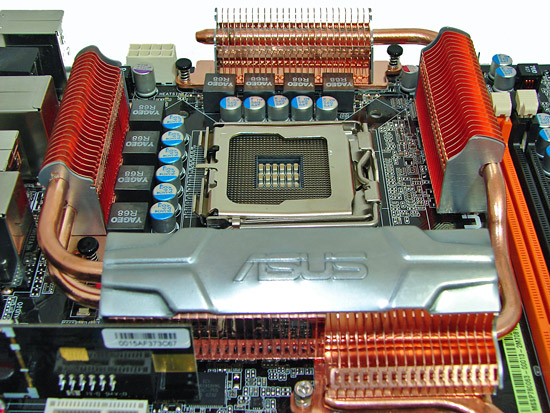
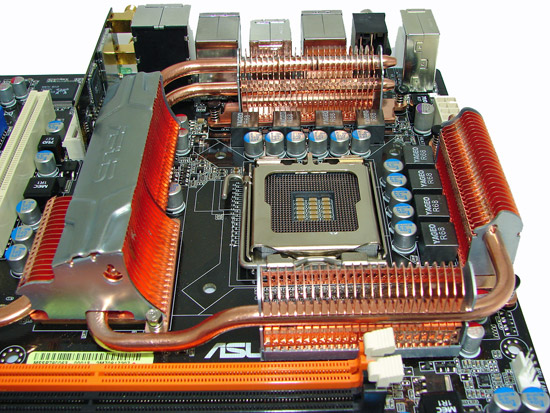
Around the CPU socket area, we find an ample amount of room for the majority of cooling solutions. We utilize the stock heatsink/fan in our base testing but also verify the ability to install several aftermarket socket 775 cooling solutions such as the Tuniq 120 and Thermalright Ultra-120 during our overclocking tests. The 8-pin EPS12V power connector is located on the edge of the board behind the PS/2 keyboard port and does not interfere with our various cooling units. However, based upon our preliminary overclocking tests, if a vertical mounted fan in an air cooling unit such as the Tuniq 120 or water cooling is utilized then additional cooling will be required on the MCH and PWM areas.
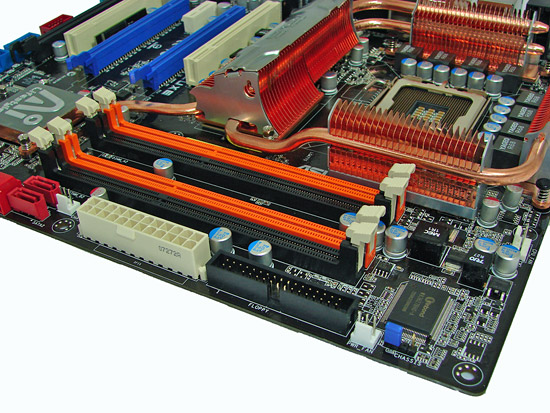
The DIMM module slots' color coordination is correct for dual channel setup based upon the premise of installing DIMMs in the same colored slots for dual-channel operation. The black and orange slot colors (Ed: Happy Halloween?) look out of place on this board, but then again we do not express any love for several board manufacturers who tend to use the entire Crayola color palette on their boards. Installing memory modules will be a slightly difficult affair with a full size video card placed in the first PCI-E x16 slot.
The 24-pin ATX power connector is properly located on the edge of the board along with the floppy drive connector. The CPU fan header is located on the far right edge of the board and works well with our test fans. Two additional fan headers are located on either side of the floppy and power connectors.
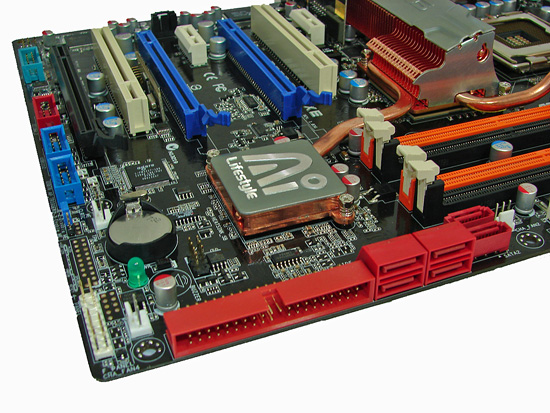
The positioning of the six red ICH9R SATA ports is excellent when utilizing the expansion slots. The ICH9R chipset is passively cooled and remained fairly cool to the touch throughout testing... well, at least until we installed our CrossFire setup and then it became quite toasty to the touch. The IDE connector is at a right angle next to the SATA ports and generally is easy to reach in our case. The chassis panel is located on the bottom left edge of the board along with the number three fan header. Right above those two items is a green LED power-on indicator, the battery, and the number four fan header. The two blue connectors are for the additional USB ports and the red connector is for the extra IEEE-1394 connector.

The board comes with three physical PCI-E x16 connectors (2 x16, 1 x8 electrical), two PCI-E x1 connectors, and two PCI 2.2 connectors. The second PCI-E x1 and PCI slots will be blocked by dual slot graphics cards. Several cards we tried in the first PCI-E x1 slot were a very tight fit if a full size card was used in the first PCI slot. Due to the location of the two x16 capable PCI-E slots, there is not much room for custom cooling solutions on the video cards. ASUS has informed us the Republic of Gamers board will have a different layout that will be conducive to custom cooling solutions. We also tried a TriFire setup on this board (three HD 2900 XT cards), but we did not have proper driver support for that to work at present - although we expect it soon.
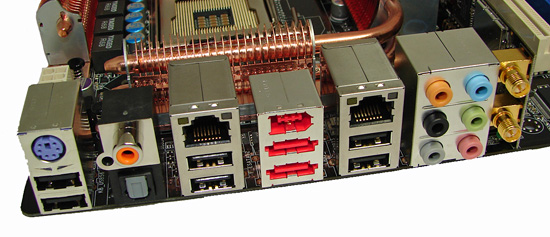
The rear panel contains the standard PS/2 keyboard port along with several other connectors. The panel also includes dual RJ-45 LAN ports with activity indicator lights, six USB ports, and optical/coaxial S/PDIF out ports. The audio panel consists of six ports that can be configured for 2, 4, 6, and 8-channel audio connections for the ADI 1988B HD codec. The board contains an 802.11n specification WiFi card that worked flawlessly with several different Draft N routers. Finally, there are two eSATA ports along with an IEEE-1394 port which completes a back panel that pretty much covers a wide array of options designed with the home user in mind.
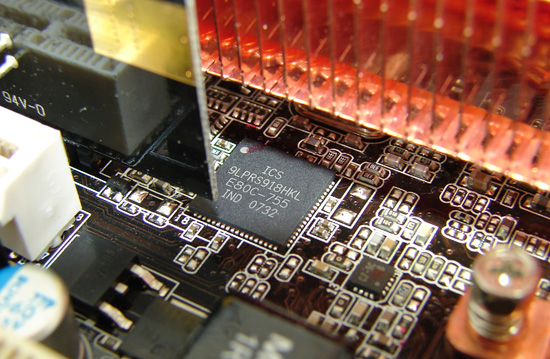
ASUS will utilize the ICS 9LPRS918HKL clock control chipset on this board.
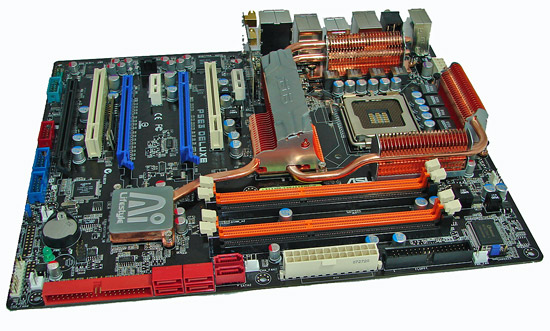 |
| Click to enlarge |
ASUS has designed a board that reminds us of cars from yesteryear: large, solid, and seemingly engineered as if it's a tank ready for the front lines. The board easily installs into a variety of cases from Antec and Cooler Master. The majority of connections are easily reached within a full size ATX case. The board features an eight-phase voltage regulator system that contributes to the excellent stability we experienced throughout testing. The P5E3 Deluxe uses 100% Conductive Polymer Aluminum Solid Capacitors. ASUS installs a total of six fan headers (1 x 4-pin, 5 x 3-pin) which is an excellent decision in our opinion. The CPU and four of the five system fan headers can be controlled via the BIOS and the ASUS AI Suite program within Windows.


Around the CPU socket area, we find an ample amount of room for the majority of cooling solutions. We utilize the stock heatsink/fan in our base testing but also verify the ability to install several aftermarket socket 775 cooling solutions such as the Tuniq 120 and Thermalright Ultra-120 during our overclocking tests. The 8-pin EPS12V power connector is located on the edge of the board behind the PS/2 keyboard port and does not interfere with our various cooling units. However, based upon our preliminary overclocking tests, if a vertical mounted fan in an air cooling unit such as the Tuniq 120 or water cooling is utilized then additional cooling will be required on the MCH and PWM areas.

The DIMM module slots' color coordination is correct for dual channel setup based upon the premise of installing DIMMs in the same colored slots for dual-channel operation. The black and orange slot colors (Ed: Happy Halloween?) look out of place on this board, but then again we do not express any love for several board manufacturers who tend to use the entire Crayola color palette on their boards. Installing memory modules will be a slightly difficult affair with a full size video card placed in the first PCI-E x16 slot.
The 24-pin ATX power connector is properly located on the edge of the board along with the floppy drive connector. The CPU fan header is located on the far right edge of the board and works well with our test fans. Two additional fan headers are located on either side of the floppy and power connectors.

The positioning of the six red ICH9R SATA ports is excellent when utilizing the expansion slots. The ICH9R chipset is passively cooled and remained fairly cool to the touch throughout testing... well, at least until we installed our CrossFire setup and then it became quite toasty to the touch. The IDE connector is at a right angle next to the SATA ports and generally is easy to reach in our case. The chassis panel is located on the bottom left edge of the board along with the number three fan header. Right above those two items is a green LED power-on indicator, the battery, and the number four fan header. The two blue connectors are for the additional USB ports and the red connector is for the extra IEEE-1394 connector.

The board comes with three physical PCI-E x16 connectors (2 x16, 1 x8 electrical), two PCI-E x1 connectors, and two PCI 2.2 connectors. The second PCI-E x1 and PCI slots will be blocked by dual slot graphics cards. Several cards we tried in the first PCI-E x1 slot were a very tight fit if a full size card was used in the first PCI slot. Due to the location of the two x16 capable PCI-E slots, there is not much room for custom cooling solutions on the video cards. ASUS has informed us the Republic of Gamers board will have a different layout that will be conducive to custom cooling solutions. We also tried a TriFire setup on this board (three HD 2900 XT cards), but we did not have proper driver support for that to work at present - although we expect it soon.

The rear panel contains the standard PS/2 keyboard port along with several other connectors. The panel also includes dual RJ-45 LAN ports with activity indicator lights, six USB ports, and optical/coaxial S/PDIF out ports. The audio panel consists of six ports that can be configured for 2, 4, 6, and 8-channel audio connections for the ADI 1988B HD codec. The board contains an 802.11n specification WiFi card that worked flawlessly with several different Draft N routers. Finally, there are two eSATA ports along with an IEEE-1394 port which completes a back panel that pretty much covers a wide array of options designed with the home user in mind.

ASUS will utilize the ICS 9LPRS918HKL clock control chipset on this board.










60 Comments
View All Comments
DigitalFreak - Tuesday, September 18, 2007 - link
Funny thing is, there were quite a few boards a year or two ago that had Firewire 800 (mainly from Gigabyte). Not sure why everyone is going back to Firewire 400.Gary Key - Tuesday, September 18, 2007 - link
Gigabyte use to have Firewire 800 and from all indications about a dozen (me included) people cared about it according to their marketing group, plus the cost was about double for the chipset. After speaking, sometimes pleading, the motherboard manufacturers are going to stick with Firewire 400 for the time being, originally most of the new boards were not going to have it.Hulk - Tuesday, September 18, 2007 - link
It's great to compare this new chipset to other current designs but a lot of people, like myself, are considering an upgrade from older designs. I have a P5B Deluxe and would like to see a 965 based chipset in the performance graphsgramboh - Tuesday, September 18, 2007 - link
I'm also a P5B Deluxe owner and I don't see much benefit to moving to P35/X38 at all. There might be a 3-5% performance boost and potentially better overclocking, but really nothing is different.I plan to wait for the next generation MB's and for DDR3 prices to drop. I might then upgrade my mainboard/memory in late 2008/early 2009.
FWIW I plan to drop in a 45nm Penryn quad core into my P5B-Deluxe in summer 2008.
Gary Key - Tuesday, September 18, 2007 - link
We will have comparisons to the older boards in the launch article, well, the article that will contain retail boards. Right now, our first retail board with the revised X38 will not arrive until this Friday. Monday might be just be a fluff PR article on the chipset specifics until we get at another board or two in.hifisoftware - Tuesday, September 18, 2007 - link
Good review.It's good to see DDR3 reviews once in a full moon (just to know where it stands performance wise), but 99% of people would rather see DDR2 review. DDR3 is just way, way more expensive without providing anything in return. I am looking for a new system so I want to know whether I should go with P35 or X38? Sounds like X38 will be more expensive and not much better (I do not care about running cooler, unless it can be translated to a higher overclock)
JarredWalton - Tuesday, September 18, 2007 - link
The quad-core FSB OC results are quite a bit higher than anything we've seen so far. Many quad cores have issues running at FSBs beyond the low 400MHz range. Then again, with the lowest quad-core having a 9X multiplier, I don't really see this as a huge limitation.hifisoftware - Tuesday, September 18, 2007 - link
Thanks. I guess then there is a reason for me to wait 2-3 weeks to decide if X38 price justifies it's OC abilities.n0nsense - Tuesday, September 18, 2007 - link
In your case will be smarter to wait for chipsets with PCIe 2 support.not to mention soon coming HybridSLI with 1600MHz support from Nvidia and X48 from intel.
and the Phenoms triple and quad cores will be released. Many new technologies. If it's not broken, let it work another half year.
n0nsense - Tuesday, September 18, 2007 - link
The passive cooling solution is good, but have some problem.The problem starting when you install this heatpipe cooled boards into cases like Enermax CS-718 (http://rusisrael.com/albums/pic/o/00/00/28/2863.jp...">http://rusisrael.com/albums/pic/o/00/00/28/2863.jp.... According to Asus support, "After all, the board is not designed to be installed "upside-down"" and they suggest to consider other cooling solutions in case of overclocking. It took me more then a week to get straight answer for the question "Does installation direction have negative affect on cooling". The question was asked about my P5N32-E SLI, but i suspect it remains true for all boards with heatpipe cooling solution. What is disappointing me most, is the fact that this information not found on Asus's site as "case compatibility" or "installation directions" or some other kind of note or warning.